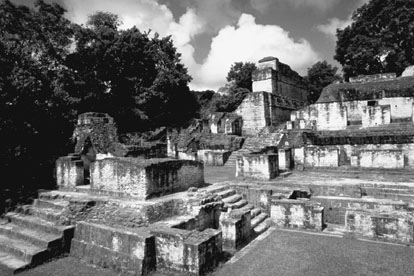

 | Page 1271 |  |
the Tikal project of the University of Pennsylvania undertook a major excavation program that has contributed enormously to our knowledge of the site. Since 1979, several Guatemalan programs of excavation have also added to our understanding, especially with regard to Tikal’s earlier years.

Mayan ruins at Tikal
(Corel)
The earliest archaeological evidence for human occupation at Tikal dates from about 800 b.c., with remains of what were perhaps scattered hamlets surrounded by a tropical rainforest. It was not until several centuries later that major developments began taking place at Tikal. By 500 b.c., pyramids were being constructed, and by a.d. 1, there were two major focuses on ritual at the site, adjacent to a residential zone. By a.d. 250, Tikal was a city with a sizable population and imposing public structures.
There is evidence that carved stone monuments began appearing at the site in the late third century (although there undoubtedly were earlier ones that are as yet undiscovered). These monuments provide details of history corresponding to the development of the site that can be discerned from archaeology. From the hieroglyphs it is clear that Tikal had a lengthy dynastic succession of kings (some thirty are referred to), and many of these kings were extremely powerful since for much of its history Tikal was one of the greatest of all Maya kingdoms. But not always: Tikal had a great nemesis—the site of Kalak’mul some 100 kilometers to the north. These sites were the two most powerful kingdoms of the Maya classic period, and most of the other kingdoms of the Maya lowlands were allied with them in complex (and at times shifting) hierarchies of polities.
In the period between a.d. 562 and 679, Tikal suffered a series of devastating defeats in war. Its monuments were smashed, and for almost 100 years no new ones were carved. Finally, a king called Hasaw Chan K’awil came to the throne, and in 695 he defeated the king of Kalak’mul. This victory ushered in a period of splendor at Tikal that lasted for almost 200 years. The latest monument from the site dates to 879, and although the site continued to have a squatter occupation for perhaps another 100 years or so, by the late ninth century it was no longer functioning as the capital city of a great kingdom.
 |  |